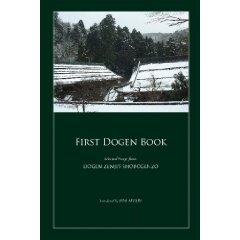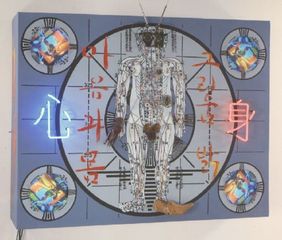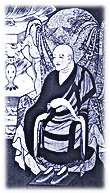Nearman’s new translation of Shobogenzo
Wednesday, May 21st, 2008 Rev. Hubert Nearman, O.B.C. has put out an ambitious new translation of Shobogenzo, a 14-year labor of love, now available from the Shasta Abbey website.
Rev. Hubert Nearman, O.B.C. has put out an ambitious new translation of Shobogenzo, a 14-year labor of love, now available from the Shasta Abbey website.

 Rev. Hubert Nearman, O.B.C. has put out an ambitious new translation of Shobogenzo, a 14-year labor of love, now available from the Shasta Abbey website.
Rev. Hubert Nearman, O.B.C. has put out an ambitious new translation of Shobogenzo, a 14-year labor of love, now available from the Shasta Abbey website.
 I am pleased to announce the print availability of “First Dogen Book”, a brand new book containing extensively annotated translations of selected fascicles from Dogen’s Shobogenzo.
I am pleased to announce the print availability of “First Dogen Book”, a brand new book containing extensively annotated translations of selected fascicles from Dogen’s Shobogenzo.
First Dogen Book is available for $19.95 from:
The fascicles included are:
 In the middle of Genjo Koan, Dogen introduces an analogy involving fish, birds, sea, and sky. This was actually the first bit of Dogen that I ever translated.
In the middle of Genjo Koan, Dogen introduces an analogy involving fish, birds, sea, and sky. This was actually the first bit of Dogen that I ever translated.
Swim as they may, fish find no end to the sea; fly as they may, birds find no end to the sky. Yet fish and bird still remain in the sea and sky as they have for ages…birds would perish instantly if they left the sky, fish would perish instantly if they left the sea.
This all seems rather understandable by Dogen’s standards. But just when we’re ready for some kind of insight or conclusion, Dogen launches into an opaque series of Chinese anagrams:
以水為命しりぬべし、以空為命しりぬべし。以鳥為命あり、以魚為命あり。以命為鳥なるべし、以命為魚なるべし。
What do they mean?
 David A. Shaner discusses Dogen’s “dropping off body and mind”, something I’ve taken up more than once (here and here ), in “The Bodymind Experience in Japanese Buddhism: A Phenomenological Perspective of Kukai and Dogen”, an excerpt from which can be found here, in the Digital Library and Museum of Buddhist Studies, a Taiwan-based initiative.
David A. Shaner discusses Dogen’s “dropping off body and mind”, something I’ve taken up more than once (here and here ), in “The Bodymind Experience in Japanese Buddhism: A Phenomenological Perspective of Kukai and Dogen”, an excerpt from which can be found here, in the Digital Library and Museum of Buddhist Studies, a Taiwan-based initiative.
Excerpts of interest:
Shinjin datsuraku is a phrase traditionally translated as “cast off body and mind.” The importance of this phrase cannot be underestimated. It occurs throughout Shobogenzo, works by Dogen not included in Shobogenzo, and is most evident in Shobogenzo Zuimonki, which was edited by Dogen’s disciples shortly after his death…In fact, Dogen stated explicitly that this is all you need to understand Buddhism.
“From the first time you meet your master and receive his teaching, you have no need for either incense-offerings, homage-paying, nembutsu, penance disciplines, or silent sutra readings; only cast off body and mind in zazen.” (Bendowa)
“Casting off,” interpreted phenomenologically, is parallel to the neutralization of thetic positings characteristic of first order bodymind awareness. Dogen is emphatic in his emphasis that casting off is not a denunciation (negative positing) of body and mind. One must cast aside all thetic positings, for example, “accepting good” and “rejecting evil.”
In keeping with the terminology utilized throughout, it would be more accurate but also more cumbersome to translate shinjin datsuraku as “cast off the mind-aspect and body-aspect.” In other words, cast off all abstractions in order to become aware of the bodymind ground at the base of all experience.
 I recently posted on a mention of the game of Go in the “Spring and Autumn” fascicle of Dogen’s Shobogenzo.
I recently posted on a mention of the game of Go in the “Spring and Autumn” fascicle of Dogen’s Shobogenzo.
You’ll recall the setting: Chinese Zen master Wanshi is commenting on an old story about heat and cold. I translated Dogen’s paraphrasing of Wanshi’s comment as:
Discussing this is like two players playing Go, where you’ve got to answer my move if you don’t want to get taken for a ride. You won’t grasp what Tozan is saying until you’ve internalized this.
Dogen then comments on the commentary:
Sticking with the go analogy for now, the real question is what’s happening with the two players. The minute you talk about two players playing go, you’ve become a bystander, which is no good because bystanders can’t play go. Playing go means one player and his opponent facing each other, it must be said.
I’ve now belatedly come across a translation of this fascicle by Francis Dojun Cook, in his How to Raise an Ox . This is an excellent, readable translation, with solid commentary, by someone who is a Buddhist scholar rather than a Zen master. I recommend it. For this section, however, he gives:
Now, the example of playing checkers is quite appropriate, but what sort of thing is this business of two people playing? If you speak of two people playing, you are still caught in duality [literally, “there will be eight eyes”]. And if you are caught in duality, there is no checker game. How can there be? Therefore, shouldn’t it rather be said that only one person is playing checkers and that he is his own opponent?
Quite a jump from “eight eyes”—which has a perfectly well-understood translation as “bystander”—to “duality”. And it is not “if you are caught in duality, there is no checker game”, but the opposite: you can’t play in the Go game if you’re outside looking at it.
I also recently acquired the three-volume Nishiyama/Stevens translation, the first complete English translation of SBGZ, done back in the ‘70s, which is now inexplicably out of print (perhaps it suffered from a lack of notes and commentary). This translation, as well, was done by Buddhist scholars and translators rather than Zen masters, and it shows it. Their translation of this portion of Shunju is the most accurate yet:
What is the meaning of “two people playing go”? If we say “Two people are playing go” it means we are a third party not actually playing. If we say such things then we must stop talking and directly face our opponent.
 Shobogenzo is Dogen’s opus magnum, but what kinds of things did he really write about? What was his focus? I’ve done a simple analysis by fasicle:
Shobogenzo is Dogen’s opus magnum, but what kinds of things did he really write about? What was his focus? I’ve done a simple analysis by fasicle:
As expected, philosophical topics dominate; these are the “famous” fascicles such as Genjo Koan and Uji. Next comes practice, ranging from Bendowa, Dogen’s chatty overview of Zen, to Zanmai-O-Zanmai, a discussion of samadhi.
Doctrine follows, although of course, the fascicles I’ve classified as “doctrine” are also somewhat philosophical in nature, typically with Dogen taking up some Buddhist doctrine and putting his own unique spin on it, such as in Sokshin-ze-butsu, sometimes translated as “Mind Here is Buddha”.
In addition to being a thinker and writer, of course, Dogen was also running a big monastery, accounting for the 10 fascicles about rules, down to details of how to run a summer practice period (Ango), what to write on message boards in the kitchen (Jikuinmon), and how to wash yourself (Senmen and Senju), these fascicles among the longer ones, meaning that they occupy a greater proportion of the whole in terms of page count.
Bringing up the rear are tradition, the topic of fascicles such as Shisho (“Certificate of Transmission”), and ethics, under which I’ve categorized fascicles like Shoaku Makusa (“Do no Evil”).
 Truth Unfolding: an annotated translation of Dogen Zenji’s Genjo Koan (PDF, 180KB)
Truth Unfolding: an annotated translation of Dogen Zenji’s Genjo Koan (PDF, 180KB)
I’m pleased to present a new annotated English translation of Genjo Koan, Dogen’s definitive, elegant exposition of the importance of practice, one of his primary themes. Dogen was the 13th century Japanese Zen master who launched the Soto school of Zen Buddhism in Japan and penned Shobogenzo, a collection of nearly a hundred essays renowned for their power, clarity and poetic beauty.
The intent is to provide an accessible introduction to Dogen’s writings for the English reader. This objective governed the translation policy, and the nature of the commentary.
The translation approach taken was to emphasize accessibility and readability, while maintaining the greatest possible fidelity to the original. Dogen presents formidable challenges to the translator. He wrote in a medieval Japanese with unfamiliar syntax and vocabulary. His writings are sprinkled with innovative stylistic devices he used to drive home his message. And the concepts he is conveying can at times seem very opaque.
Soto Zen has taken firm root in the West over the last three decades. This has been accompanied by half a dozen or more English translations of all or part of Shobogenzo. These translations are the fruits of the labor of esteemed Zen masters and scholars. Still, there is ample room for new translations with new insights. The density and interrelatedness of Dogen’s writings means that each hour or day or week or month spent pondering a phrase or sentence or paragraph can add value to the enterprise of rendering Dogen into an English which accurately conveys his meaning and style. This translation is yet another such effort.
The concept of fidelity operates on many levels. One such level is vocabulary, which is mapped precisely here, even in cases where this requires the use of unfamiliar words or Buddhist technical terms, which are then explained in the notes. Examples include both Chinese Buddhist terms which are mapped back to their Sanskrit equivalents, such as dharma, as well as native Japanese words such as satori. A second level is style, which is mirrored in these translations to the absolute extent possible. For instance, repetitions which might not usually be found in English are carried though. Where Dogen omits a word it is omitted in the English as well. If Dogen is in a lyrical or poetic mode, that should be mirrored in the translation as well.
One level which is not mapped religiously, on the other hand, is that of Japanese syntax, the mechanical mimicking of which simply yields wooden, awkward English. Japanese is Japanese and English is English. Assuming that the original Japanese was accessible and readable, which in the case of Dogen it certainly was, an “accurate” translation should replicate that accessibility and readability in English.
The most important question in terms of fidelity is meaning. Ideally, if the words and syntax and style are carried through to English, the meaning will follow. Even if the original is ambiguous, or even if it has multiple meanings as is sometimes the case in Dogen, a skillful translation can reproduce that same ambiguity or multiplicity of meanings. There are times, however, when circumstances force the translator into a particular interpretation. In that case, it’s important to take full advantage of every available clue, including syntactic details, character usage, and, notably, the relationship to preceding and succeeding sections—in other words, the flow. What should not factor into the interpretation is the translator’s preconceived notions of what Dogen “must have been talking about.”
Another major source of insight in interpreting Dogen is the extensive body of translations available both in Japanese and English, as well as commentaries, mostly in Japanese. There are, however, limits to their usefulness. Some translators have laudably taken it upon themselves to translate large volumes of Dogen’s writings, such as Shobogenzo in its entirety, which reduces the amount of time they can spend on any given essay. In other cases, apparent mistakes in interpretation are propagated from one commentator or translator to another. In any case, in addition to referring extensively to preceding translations and commentaries, we present those alternative translations to the reader (in the form of footnotes to avoid disrupting the flow of the notes), less to criticize potentially misleading translations as to give the reader the opportunity to draw her own conclusions. Given that objective, attributions to specific translators are often omitted, since the intent is not a scholarly review of previous translations.
Finally, to make Dogen more accessible to those getting to know him for the first time, the decision was made to accompany the translation with extensive translator’s notes. The annotations are not in general meant to elucidate the essay’s deeper meaning. Dogen can speak for himself if only given the voice to do so. Rather, the focus is on pointing out interesting or challenging aspects of Dogen’s prose and possible alternatives for interpret-ing or translating it. This opportunity to clarify aspects of Dogen’s writings in the notes makes it possible for the translation itself to adhere more closely to the original. The annotations also present historical and cultural background to enhance the reader’s understanding. The translated essay is first given by itself, to avoid distracting the reader with the annotations. The translations are then repeated, this time interspersed with translator‘s notes. Perhaps the reader will find it useful to read the stand-alone version, then the annotated version, and finally return to the stand-alone version to experience something akin to what readers and listeners in the 13th century did.
This translation supercedes my earlier attempts, including “Unfolding Puzzle.” I welcome comments and criticisms.
[Picture is of an “ojo de dios” by Jay Mohler.]
Grumpiness alert. In a post on his Hardcore Zen blog, Brad Warner is pitching the Nishijima/Cross translation of Shobogenzo:
In case anybody’s been looking for the Gudo Nishijima / Chodo Cross translation of Dogen’s Shobogenzo and couldn’t find it, or else found it for a ridiculously high price, check out the link below or click on the title of this article. The full four volume set is now available through Amazon.com at just $23.99 per volume.
This is the best, most reliable English translation of the complete Shobogenzo that ever has been or ever will be produced. I’ve sat down with the Japanese version and this translation open to the same passage a great number of times and it’s like someone gave you magic glasses that enabled you to read exactly what the original Japanese text says in crystal clear English. You cannot do this with any other edition.
It’s great to see this available once again. Buy a set or be a loser!
I suppose it’s the “best” translation of the complete Shobogenzo because it’s the only one currently in print (the Nishiyama/Stevens translation, the only other complete translation, is out of print). As for whether or not it’s the best that “will ever be produced,” I guess Zen masters must be able to foresee the future. As for whether it’s the best in terms of the translation of any particular fascicle which has been translated elsewhere, the anwer is—far from it.
These “magic glasses” give us text like the following (from Bendowa):
When the budda-tathagatas, each having received the one-to-one transmission of the splendid Dharma, experience the supreme state of bodhi, they posess a subtle method which is supreme and without intention.
Which parses the Japanese incorrectly, interprets it wrongly, and renders it into broken English. Chodo Cross has referred to the work of translating Shobogenzo, or rather Nishijima’s modern Japanese translation of it, as “donkey work.” Let’s just say—that attitude shows.
It’s odd that Brad, who espouses a modern, in in-your-face brand of Zen, would be so attached to this overly literal, tired translation.
Western Zen students would be far better off with one of the Cook translations, such as How to Raise an Ox, or Sounds of Valley Streams . Or, one hopes, at some point, a fluent, informed, new definitive translation.
 It’s time to play another game of “what would Dogen have really been saying”! Here are your choices:
It’s time to play another game of “what would Dogen have really been saying”! Here are your choices:
1. Time is like a mountain range you can look out across; it does not simply recede into the past.
2. Time is not like a mountain range you can look across, fading into the distance.
This, of course, is from Uji , where Dogen writes ã??ã?®æ˜¨ä»Šã?®é?“ç?†ã€?ã?Ÿã? ã?“れ山ã?®ã?ªã?‹ã?«ç›´å…¥ã?—ã?¦ã€?å?ƒå³°ä¸‡å³°ã‚’ã?¿ã‚?ã?¤æ™‚節ã?ªã‚Šã€?ã?™ã?Žã?¬ã‚‹ã?«ã?‚らã?šã€‚
Nearly all translations take the interpretation that time is like a postcard of a mountain range. Nishijima/Cross:
Even so, this Buddhist principle of yesterday and today is just about moments in which we go directly into the mountains and look out across thousand or ten thousands peaks; it is not about what has passed.
This is a serviceable translation, with the minor exception of being wrong. The principle is not about moments where we saw the mountains; it is that past and present are (or are not) the mountain view. More importantly, they reverse (in my opinion) what Dogen is saying about mountains and time.
Tanahashi/Welch somehow manage to mangle this sentence even more badly:
Yet yesterday and today are both in the moment when you directly enter the mountains and see thousands and myriads of peaks. Yesterday’s time and today’s time do not go away.
They completely leave out the word “concept” from the original; transform past and present needlessly into yesterday and today; mistranslate jisetsu as “moments”; have time being “in the moment” rather than “the case of”; and introduce a gratuitous sentence break—a sure sign that their parsing is off. The awkward “thousands and myriad” just adds insult to injury. Someone should take away these guys’ translating license.
But the real question is whether time is, or is not, like the series of mountain peaks. The syntactic problem here is that the Japanese has the structure “doing A, doing B not,” where A is the mountains and B is passing away. This gives rise to an intrinsic ambguity: it could be “(doing A, doing B) NOT” or “doing A, (doing B NOT).”
Beyond the syntax, however, there are a number of clues for us here. First and foremost, Dogen has spent the entire preceding part of the essay telling us precisely that time is not a linear sequence—which is exactly what the range of peaks is! The sentence starts off with a “but” which makes sense only if the sense of the entire sentence is negative. And the word “simply” (J. tada) right at the beginning—which Tanahashi/Welch toss away—pairs naturally with the “not” at the end.
Therefore, I believe that the “not” in the original extends to both time passing away and the view of time as a linear series of mountain peaks. Sorry if you were liking the analogy of past and present as a mountain range.
My translation would be:
But do not conceive of past and present simply as a vista of a innumerable peaks that you look out over from within the mountains, receding off into the distance.
This is somewhat disconcerting. Typically different interpretations might yield a shift in nuance or emphasis. But here they are diametrically opposed. And impeccably credentialed Zen masters and eminent scholars all assure us that Dogen is in fact exhorting us to rush out into the wilderness and gaze on mountain ranges as an excellent analogy for how time works.
What is a student to do? Simply understand the potential issue and make up your own min—assuming the translator deigns to point out the problem to you as I am doing here.
 Translating Dogen demands a philosophy of translation. Many of those translating Dogen are not professional translators, which perhaps is why we so often fail to see coherent philosophies being applied.
Translating Dogen demands a philosophy of translation. Many of those translating Dogen are not professional translators, which perhaps is why we so often fail to see coherent philosophies being applied.
The simplistic choice is between “literal” and “paraphrased” translations. These styles have names: formal and dynamic equivalence, or “form equivalence” and “functional equivalence”. Sometimes the terms “word for word” and “thought for thought” are seen as well.
The debate between the two schools is heated and often uninformed. The literalists accuse the paraphrasers of inserting their own opinions into the translation. The paraphrasers respond that the literalists create wooden translations that no one wants to or can read.
There are problems with both sides of course. No translation can be completely literal, since it must use the vocabulary and syntax of the target language. And if the objective of the paraphrasers is to “create the same effect in the mind of the reader of the translation as the original did in the mind of its,” clearly this is impossible given that the readers exist in different cultural and historical contexts.
Of course, which style to use depends on the goals of the translation and the target audience. A wider, more general audience would call for a more dynamic style, a narrower, more expert audience a more formal one. When the source and target languages are distant linguistically, a more dynamic style may be the only choice.
Dynamic equivalence was developed by the linguist Eugene Nida for Bible translation. He insisted that only this approach could create an approachable, meaningful Bible for the masses. Bible translations are clearly a useful analogy for translating Dogen. An interesting approach developed for the God’s Word translation is called closest natural equivalence translation.
Closest natural equivalence claims to achieve the following:
CNE asserts that an awkward translation by definition is not faithful to the original, while at the same time natural-sounding language in and of itself never suffices to make a translation good.
The obvious objection is that it may not be possible to convey meaning accurately in natural sounding language. I would assert, however, that it is simply a matter of time and effort on the part of the translator. It should not be out of the question to spend an hour, or even a day, on a single sentence. Naturally, this reduces translator throughput dramatically. It is striking, however, how in many cases, once the effort is made, the resulting natural English undeniably conveys the meaning of the original in a way much more compact and compelling that a mechanical translation might.
The web page quoted above ends with a caveat:
Translation can never be completely objective. Even when operating under the assumptions of closest natural equivalence, translators cannot produce a perfect translation. Translators use cautious judgment and maintain a keen awareness of all the factors needed for a full understanding of the source text. Among other things, translators need to understand the original language’s grammar and syntax, appreciate and understand literary devices used by the original authors, understand what kind of audience the original author had in mind when writing, and understand the modern target audience and its language. Because these factors call for balance and judgment, every translation (even those produced using closest natural equivalence) can be improved.